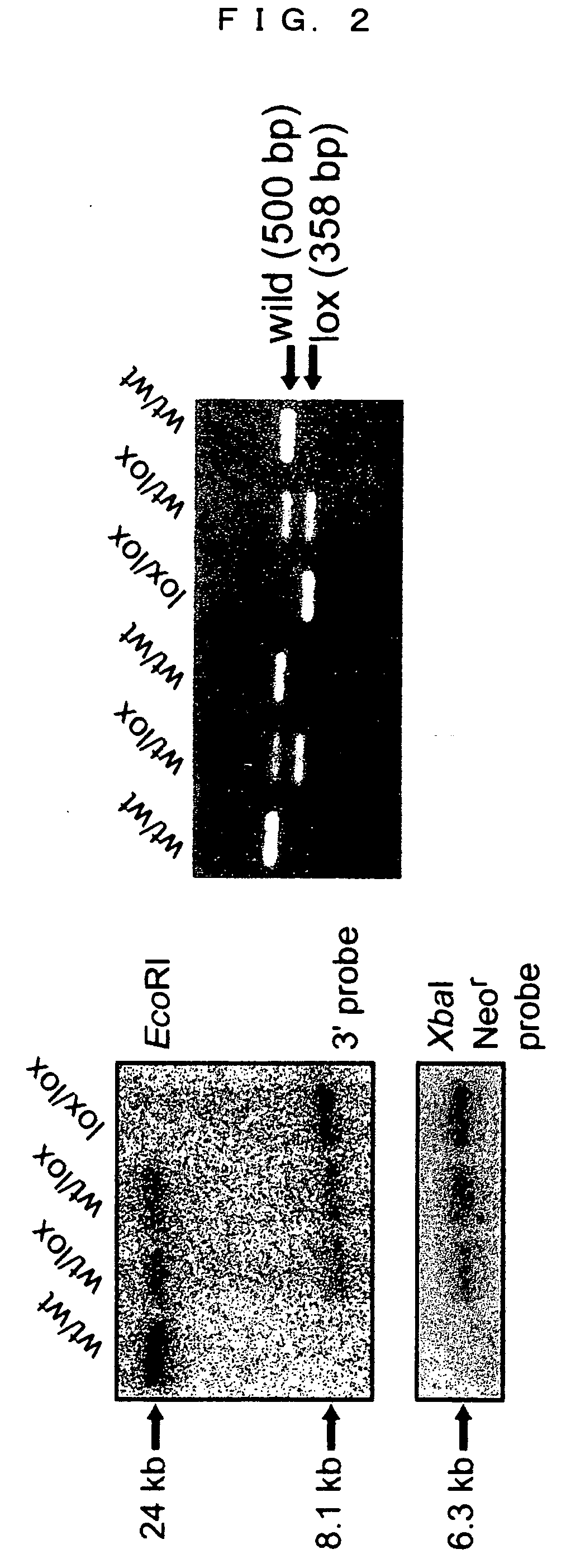Knockin non-human animal and tissue-specific MnSOD knockout non-human animal
a non-human animal and tissue-specific technology, applied in the field of knockout non-human animals, can solve the problems of difficult to evaluate the sensitivity of each organ to reactive oxygen species or an amount, difficult to model the effects of reactive oxygen species on each organ separately, and impossible to evaluate the effects of reactive oxygen species
- Summary
- Abstract
- Description
- Claims
- Application Information
AI Technical Summary
Benefits of technology
Problems solved by technology
Method used
Image
Examples
example 1
[0040] In the present example, knockin mice in which exon 3 of the MnSOD gene was interposed between two loxp sequences were generated, as shown in FIG. 1.
[0041] A 129 / Sv mouse genome library (λFIXII; Stratagene) and mouse MnSOD cDNA as a probe were used to clone an approximately 14 kb genomic gene containing five exons of MnSOD into a pBSKII vector (Stratagene).
[0042] The isolated MnSOD genomic gene was used as a template to amplify a 5′ flanking 1.3 kb genome fragment by the PCR method using a primer set of an NotI anchored sense primer (SEQ ID NO: 1) and an SalI anchored antisense primer (SEQ ID NO: 2), and the resulting fragment was cloned into a pMC1DT-A(B) plasmid (Oriental Koubo).
[0043] The isolated MnSOD genomic gene was used as a template to amplify a 3′ flanking approximately 6 kb genome fragment by the PCR method using a primer set of an XhoI anchored sense primer (SEQ ID NO: 3) and an SalI anchored antisense primer (SEQ ID NO: 4). The resulting fragment was cloned, at...
example 2
[0050] In the present example, model mice in which MnSOD was specifically deficient in liver cells were generated and analyzed.
[0051] Rat albumin promoter (Alb)-Cre transgenic mice (THE JACKSON LABORATORY, 600 MAIN STREET, BAR HARBOR, Me. 04609, USA) expressing Cre recombinase in hepatocytes were mated with the MnSOD flox mice generated in Example 1, as shown in FIG. 3.
[0052] As a result, liver-specific MnSOD-deficient mice were not lethal, and outwardly, were not different from the wild-type.
[0053] The DNAs obtained from livers were used to confirm the efficiency of the recombination by the Southern blot method (FIG. 4).
[0054] When restriction enzyme HindIII and the exon4 probe were used, 6.0 kb DNA fragment and 4.0 kb DNA fragment were detected in the MnSOD flox allele (lox / lox) and MnSOD-deficient allele (del / del), respectively.
[0055] When restriction enzyme EcoRV and the exon4 probe were used, 8.8 kb DNA fragment and 6.8 kb DNA fragment were detected in the MnSOD flox allel...
example 3
[0059] It was reported that fats and glycogen were accumulated in the liver of the MnSOD-deficient mice caused by the MnSOD deficiency. Therefore, in the present example, the liver-specific MnSOD-deficient mice generated in Example 2 were used to carry out the hematoxylin-eosin (HE) staining, periodic acid-Schiff (PAS) staining, and Oil Red O staining. As a result, no significant difference was observed in the accumulation of glycogen (FIG. 7).
[0060] Further, on the basis of the expectation that organs in the deficient mice are exposed to reactive oxygen species more than in the wild-type, amounts of lipoperoxides [malondialdehyde (MDA) and 4-hydroxy-alkenals (4-HAE)] were measured. No significant difference was observed in comparison with the control (FIG. 8).
[0061] From the above results, it was suggested that the changes observed in the liver of the conventional MnSOD-deficient mouse was caused by the deficiency of MnSOD in the whole body, but not by the deficiency of MnSOD in ...
PUM
| Property | Measurement | Unit |
|---|---|---|
| resistance | aaaaa | aaaaa |
| drug resistance | aaaaa | aaaaa |
| periodic acid-Schiff | aaaaa | aaaaa |
Abstract
Description
Claims
Application Information
 Login to View More
Login to View More - R&D
- Intellectual Property
- Life Sciences
- Materials
- Tech Scout
- Unparalleled Data Quality
- Higher Quality Content
- 60% Fewer Hallucinations
Browse by: Latest US Patents, China's latest patents, Technical Efficacy Thesaurus, Application Domain, Technology Topic, Popular Technical Reports.
© 2025 PatSnap. All rights reserved.Legal|Privacy policy|Modern Slavery Act Transparency Statement|Sitemap|About US| Contact US: help@patsnap.com



